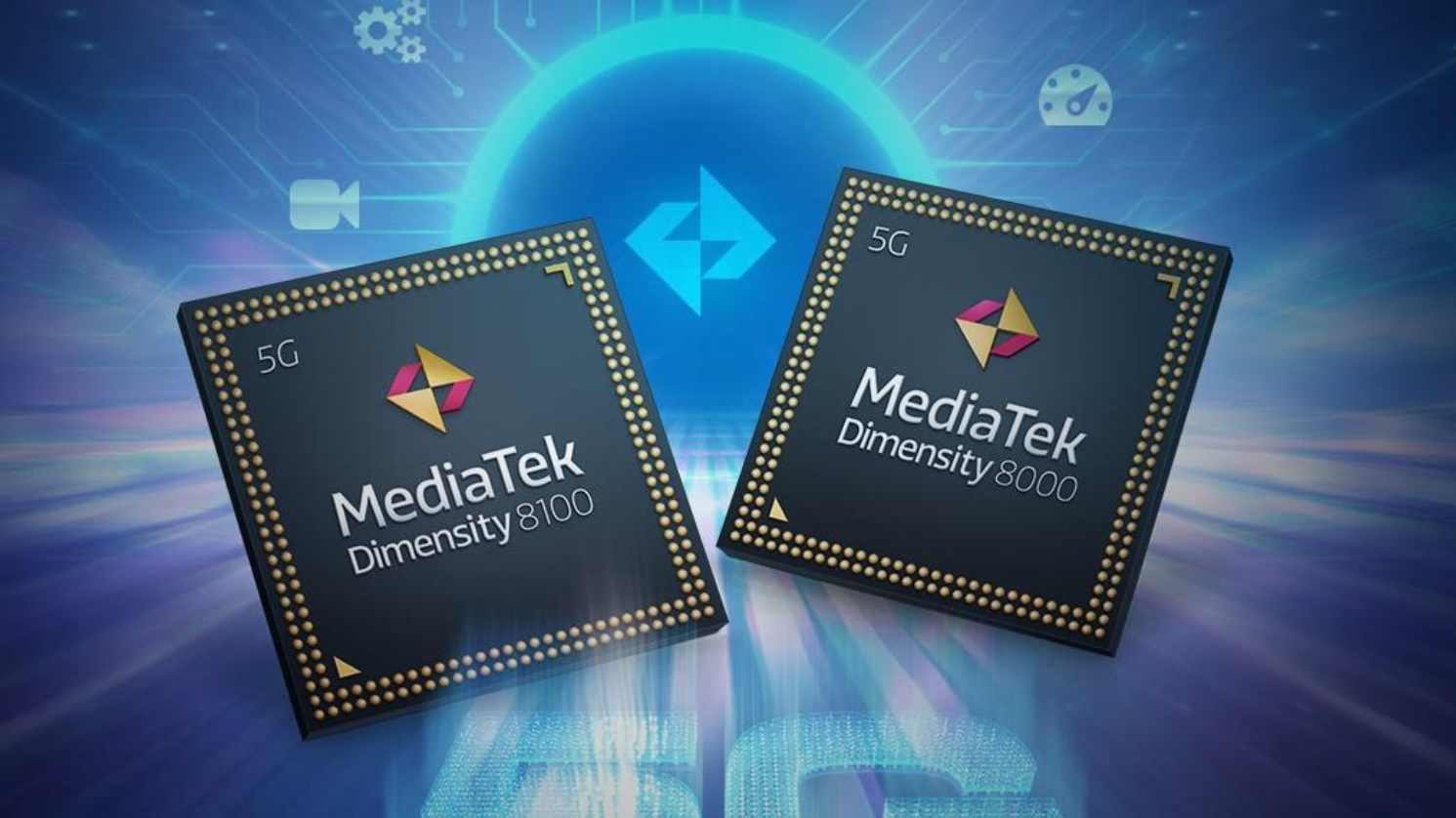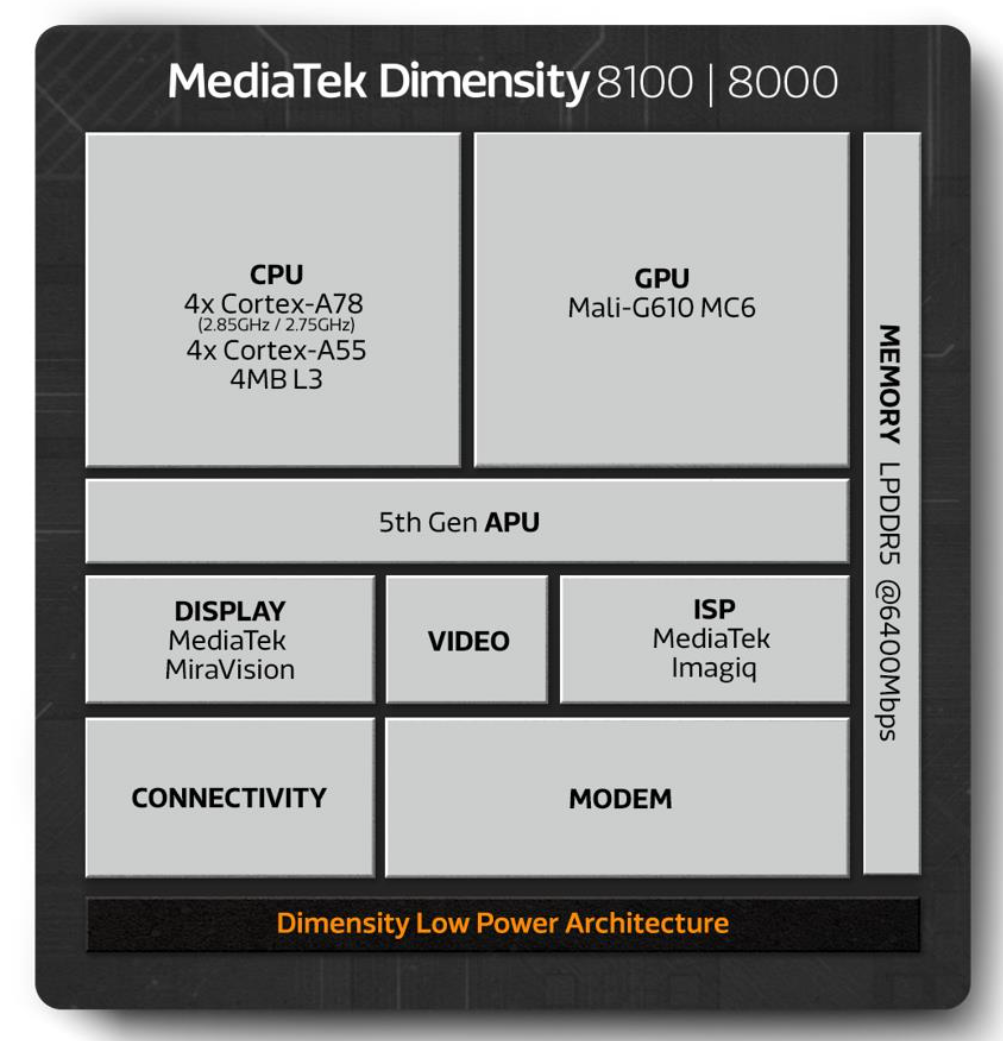Read update
- Qualcomm disagrees with MediaTek's market numbers
MediaTek has just announced two new Dimensity chipsets with a curious target. Joining the company's flagship push with the Dimensity 9000, MediaTek is showing off the new 8100 and 8000 chips, meant to go head-to-head with the Qualcomm Snapdragon 888 and 870. Those might be last year's parts, but with the rise of gaming phones and sub-flagships that use older chipsets, it could be a smart move.
First, the specs:
|
Dimensity 8100 |
Dimensty 8000 |
|
|
Big CPU cores |
4x A78 @ 2.85Ghz |
4x A78 @ 2.75Ghz |
|
Small CPU cores |
4x A55 |
|
|
RAM |
Quad-channel LPDDR5 |
|
|
Storage |
UFS 3.1 |
|
|
GPU |
Mali G-610 (6-core) MC6 GPU |
|
|
Node |
5nm (N4) TSMC |
|
|
Connectivity |
Bluetooth 5.3, 2x2 Wi-Fi 6E |
|
|
Modem |
3GPP R16 ready, sub-6GHz, 2CC/200MHz aggregation |
|
|
Camera |
Up to 200 MP camera support and 4K60 HDR10+ video, 5Gpixel/s ISP, two triple-exposure pipelines |
|
|
Misc |
4MB L3 cache, Open Resource Architecture for manufacturer customization |
|
On the CPU side, you have four A78 cores (at varying clocks between the two models) and four smaller A55 cores, paired with 4MB L3 cache, built at a 5NM TSMC node (N4) and paired with a Mali G-610 6-core GPU. It also has some new perks, like Bluetooth 5.3 support and Wi-Fi 6E support, and the modem it's paired with supports the latest 3GPP standards for sub-6GHz 5G (no mmWave) and up to 200Mhz 2CC aggregation. In short, not bleeding edge, but it has some modern perks.
MediaTek says it should have performance in the same ballpark range as last year's Snapdragon 888, with certain workloads and efficiency actually favoring MediaTek, though we'll have to see if these claims actually pan out.
If you've followed chipset news very much in the last year, you may notice that some of these details are on the older side. There aren't any super-huge Cortex X1 or X2 cores here, nor is MediaTek using the latest A710 or A510 ARM core designs released last year that it has in the Dimensity 9000. By the numbers, this is an older-sounding chipset, but that's actually what it's up against.
Of course, MediaTek can't be sure exactly how its customers, the smartphone makers themselves, will end up using these chipsets in products. But the company made repeated comparisons to the Snapdragon 888 in our briefing, and when I asked what its target was, it called out the Snapdragon 888 and 870 specifically.
That might seem like an odd move, but in the current market, it really isn't. In the outright flagship space, you might see the latest and greatest chipsets, and that's the market we're told the bigger Dimensity 9000 is targeting. But sub-flagships and gaming phones often use slightly older hardware to deliver a better price. Samsung's Galaxy S21 FE launched in 2022, but it is using a Snapdragon 888. Some gaming phones also opt for slightly older internals to lower prices for a flagship-like gaming experience. And occasionally, the less premium versions of phones in a flagship family will use an older part, too, as the upcoming Find X5 is rumored to, according to recent leaks. In short, there are a lot of instances where an older flagship chipset is the first choice for value reasons.
Sometimes new phones, like the S21 FE above, use older chipsets.
Taking that into account, the new chipsets make more sense as a way to complete a lineup against Qualcomm. You've got the Dimensity 9000 bringing the heat to Qualcomm at a flagship space, and the new Dimensity 8100 and 8000 targeting the older 888 and 870. It could even sway hardware partners thanks to little improvements that come from simply being more recent, like Bluetooth 5.3 support and a better node — which could equate to better-sustained performance in things like gaming phones and potentially better power efficiency, we'll have to see.
MediaTek says the first phones with the 8000 series will be launched a little after MWC, so we may not have long to wait for it to materialize, either.
Hidden at the bottom of today's announcement (and not even covered in our brief with the company) is the "new" Dimensity 1300. If that name sounds familiar, it's because leaks indicate the Nord 2T will use the chip. It was rumored to be an updated Dimensity 1200, and by the numbers, it appears to be, with four big A78 cores (one at a higher clock), four smaller A55 cores, and an upgraded G77 GPU, built to an updated 6nm node.
MediaTek also highlighted some of its biggest recent achievements. According to IDC, it is the #1 chipset vendor in the US as well, building upon its worldwide success, where it's been the #1 chipset vendor for six consecutive quarters. The company attributes that success to high-volume phone models like Samsung's entry-level and mid-range lineup, Motorola's phones, and self-branded models from carriers like Boost and T-Mobile.
Qualcomm tells us it doesn't understand these claims, pointing out data from Counterpoint which disagrees with it, indicating Qualcomm has 55% of the market while MediaTek as 37% in the quarter (Q4 2021) claimed.
In more US-related news, the company hopes to get mmWave certification for a major US operator later this year, with the first MediaTek-powered mmWave 5G mid-range smartphone expected to debut in the second half of the year.
UPDATE: 2022/03/03 17:18 EST BY RYNE HAGER
Qualcomm disagrees with MediaTek's market numbers
Qualcomm reached out to us following publication to state that they disagree with MediaTek's IDC numbers, pointing out that Counterpoint still claims they are #1 in the US. MediaTek and IDC have revised their figures slightly, but both still claim MediaTek is the #1 chipset vendor in the US at 48.1% of market share in Q4 2021 (compared to an estimated 43.9% for Qualcomm.
A slide with IDC's original numbers has been removed, and our coverage has been updated with this additional information.



.JPG)